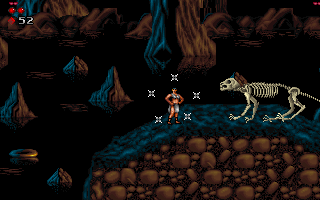Keith Schuler designed Realms of Chaos and released it through Apogee as a DOS shareware title in 1995. Schuler would go on to contribute to Duke Nukem 3D, Shadow Warrior, and Borderlands.
The game's premise is that the brother and sister team of Endrick and Elandra must rid the land of evil in a side-scrolling action game that broadly resembles Rastan. Endrick is a swordsman with a strong melee attack, while Elandra is a sorceress who can attack at range as long as she has gems for ammunition and she can jump farther than her brother. The player must switch between them depending on circumstances, but if either one dies the player must restore a saved game to continue.
There's a loose story to the game that develops in text after each episode, and that story is tongue in cheek, particularly the revelation that the game is a distant sequel to Schuler's previous puzzle-solving game, Paganitzu. Profile pages on the characters inform us that Endrick likes chocolate and Elandra loves strawberries and poodles. But in terms of how the game looks and plays, it carries the sword-and-sorcery aesthetic as well as any game. The heroes battle their way through lushly VGA-rendered forests, swamps, dungeons, and caverns that are inhabited by creatures such as giant frogs, rock men, goblins, and minotaurs. Endrick could almost pass for a descendant of Conan and Elandra is a hot chick who throws fireballs in a scant outfit.
Schuler demonstrates a strong and varied grasp of level design. Some levels are mostly horizontal, some emphasize verticality. There are various types of traps and gadgets such as elevators and swamp rafts. Some levels are mazelike. There's a forced-scrolling type that forces the player to move quickly. Another requires that you ride a snake-like platform upward. The need to switch between characters is well-distributed; you never go too long before switching or get the sense that one character is better than the other.
Although the game uses a lot of the sampled sound effects common to shareware games of the era, the animation is particularly good, with touches such as a Endrick sheathing his sword when it's not in use. It can be completed well within a day, although it's not lacking in challenge. The difficulty increases at a smooth rate through the first, free episode, but the second episode has a significant difficulty spike and it's not impossible to get stuck in a position where it's exceptionally hard to defeat the final boss monster, a questionably designed stone giant that involves random elements in addition to the creature's regular attack pattern. Episode 3 is more in line with the first but there are sections that will almost certainly require that the player save and restore a lot because certain fatal traps can only be found through trial-and-error.
A modest game but good for a dull afternoon.









